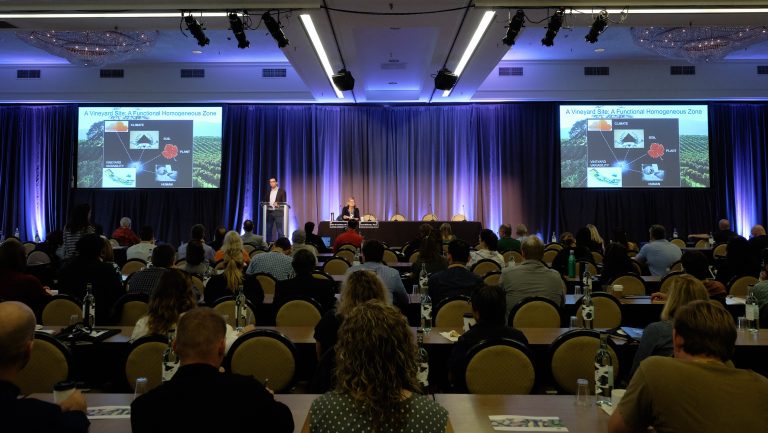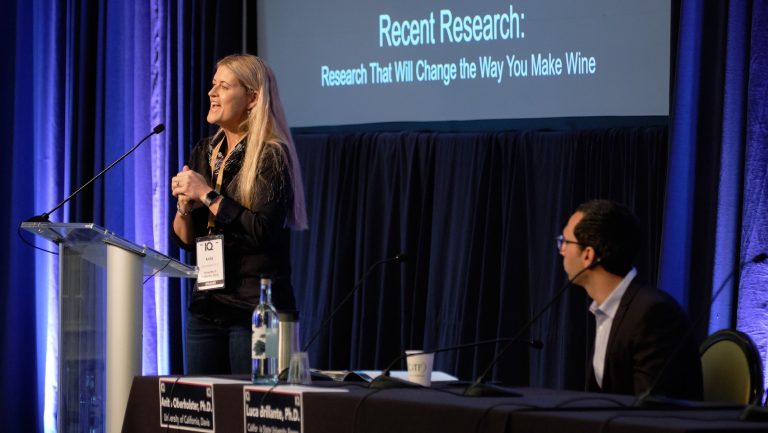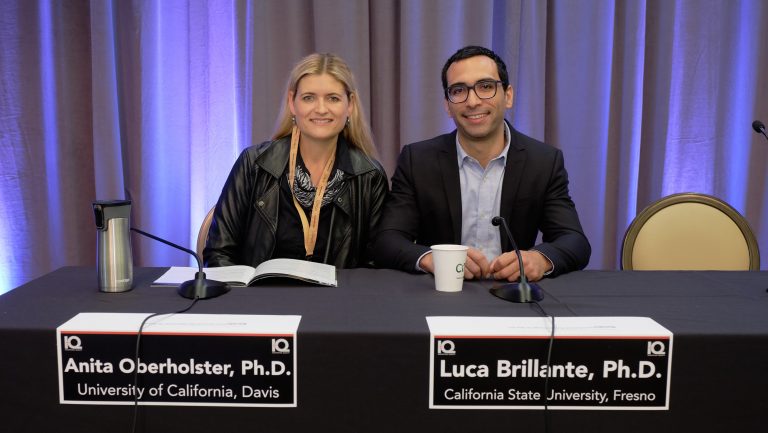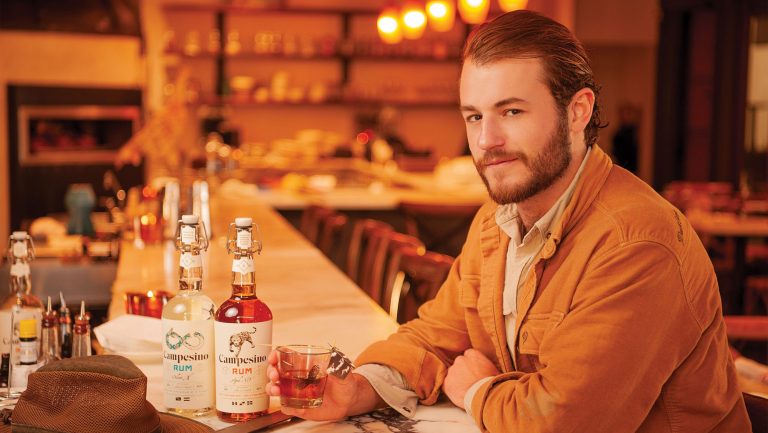A panel titled Recent Research: Research That Will Change the Way You Make Wine, started off the second and final day of discussions at Wine Business Monthly’s Innovation and Quality, or IQ, forum. The fifth annual event, held May 22 and 23 at Silverado Resort in Napa, California, brought wine industry professionals up to date on cutting-edge innovations for improving wine quality.
The panel featured a pair of experts: Anita Oberholster, Ph.D., an associate specialist in enology in the Department of Viticulture & Enology at the University of California at Davis, and Luca Brillante, Ph.D., an assistant professor and the Bronco Viticulture Chair at California State University at Fresno.
They presented their findings from the last couple of years on site-specific management in viticulture, smoke taint, filtration techniques, and winery cleaning and sanitation, which can now be applied in attendees’ wineries for more efficient, economical, and quality-oriented wine production.

Don’t miss the latest drinks industry news and insights. Sign up for our award-winning newsletters and get insider intel, resources, and trends delivered to your inbox every week.
Higher Revenue in Site Specificity
Brillante began with a lesson on “one of the most abused words” in the wine industry: terroir. He argued that quality doesn’t factor into terroir, saying that a single terroir can be extremely variable in terms of physical characteristics. Brillante also argued that perhaps terroir is really not the right word to describe vineyard land. “Be careful with your words,” he said. “Terroir is not only the soil but a collection of the physical and biological environment, and of course, the traditional and cultural practices are very important.” He offered an alternative term. “When we speak of terroir, we cannot only indicate a site,” he said. “Using the term site would be much better.”

Drawing on his experience working in Bordeaux and Burgundy, Brillante presented a recent irrigation experiment he performed in a Sonoma vineyard. Measuring water potential throughout the site, he divided the vineyard into two zones based on the stress level of the vines, which can indicate a difference in fruit quality. On further testing, the two zones were consistently distinct, presenting variability between the grape composition of the two areas with regards to measurements like Brix—during the final 40 days of ripening, there was almost a difference of four Brix between the zones—and anthocyanin content.
Precision viticulture—the attempt to assess and understand the variability throughout a site—affords an opportunity to increase revenue, according to Brillante. Instead of attempting to even out the differences within a vineyard with practices like irrigation, wineries might better perform a selective harvest to optimize for premium, site-specific wines, he suggested, which they can sell at a higher price point.
The Good and Bad News on Smoke Taint Research
Oberholster’s update on smoke taint research was the panel’s hot-button topic. She began by reviewing a few key points: All grapes are sensitive to smoke exposure, and it is unknown which grapes are less sensitive than others; volatile phenols—the compounds in smoke that are absorbed by the grapes and bind to their sugars to create smoke taint—are absorbed into a grape’s skin very quickly, so not much can be done to prevent them from getting into the berry if it’s exposed; the fresher the smoke, the higher the risk, as phenols deteriorate over time; volatile phenols are extracted very quickly during winemaking; and while volatile phenols remain mostly stable throughout bottle aging, a change in the matrix of the wine—for instance, a decrease in fruity or floral characters—can have a large impact because it enables the smoke to stand out more.

Oberholster went on to list the recommended winemaking treatments used to combat smoke taint—among them picking by hand, adding “fruity” yeast (strains that bring out fruit flavors), limiting skin contact, employing cooler fermentations, and adding oak for complexity—which she tested in her own experiments in 2017 and 2018 with tainted grapes from Oakville, Alexander Valley, and the Silverado Trail.
The bad news: Oberholster’s conclusions were that these methods are mostly ineffectual. “Basically,” she said, “what I’m telling you is: No winemaking treatment had a huge impact on the smoke taint.” The good news, she said, is that a lot of research is underway to develop new technologies or improve existing ones—like treating the wines with a range of different enzymes, and employing a type of reverse osmosis called differential filtration—so they’re more effective in removing smoke taint.
The Standards of Filtering and Sanitation
Though Oberholster said filtration and sanitation are “not very sexy,” she noted that they are two important topics of research. A recent filtration study she conducted tested three different membrane filters, measuring for their efficiency and potential impact on wines. While there was some difference in efficiency of flow rate between the filters, Oberholster said she found zero compositional impact on pH and residual sugar, for example, and a very minimal sensory impact on the wines.
Winery cleaning and sanitation experiments conducted recently by Oberholster and her colleagues concluded that while the general protocols for cleaning and sanitizing in wineries work well, the lack of effective manual scrubbing on certain parts of a tank—like the bottom, where there might be standing water, or the gasket in the door—caused the biggest problems. “There’s nothing wrong with the cleansers, nothing wrong with the sanitizers,” said Oberholster. “They work perfectly, but you need manual cleaning in those spots because a spray bottle is never going to get there and a sanitizer cannot do its job if [the tank is] still dirty.” Dirty hoses are also a problem, she said, because they contaminate the water that’s used during the final rinse after sanitizing.
“There’s no replacement, unfortunately, for that manual scrubbing,” she concluded. “Sorry, guys,” she said, inspiring a chuckle from the audience.

Dispatch
Sign up for our award-winning newsletter
Don’t miss the latest drinks industry news and insights—delivered to your inbox every week.







